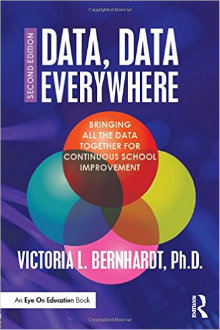Bring Data Together for School Improvement
Data, Data, Everywhere: Bringing All the Data Together for Continuous School Improvement, Second Edition
By Victoria L. Bernhardt, Ph.D.
(Routledge/Eye on Education, 2016 – Learn more)
Data, Data Everywhere is, at its heart, a guide to making sense of all of the information that schools collect on a daily basis and using it to determine specific actionable goals for school improvement.
To put that another way, teachers and administrators collect a lot of data: test scores, attendance records, office referrals, benchmarking, formative and summative assessment results, family involvement, professional development participation, and much more.

After explaining the CSI Framework, each chapter of the book is broken down into four basic components: an overview of a specific element of the framework, an explanation of how to collect and analyze the data, reflection questions, and application opportunities. Additionally, each chapter has a suggestion for the amount of time it should take to fully consider each component.
Making data part of collaboration
An important recommendation by Bernhardt is to involve as many voices as possible in the school improvement process. This is radically different than the traditional method of pulling together a team of teacher leaders and administrators with one or two parents to make the decisions for the school’s improvement plan.
By involving every voice, the plan is more likely to have increased ownership, collaboration, and consensus within the building. As Bernhardt says
When school staff agree and commit to a shared vision, they are collaborating on what they know and believe will make a difference for student learning. They create common understandings about what to teach, how to teach, how to assess, and how each person will treat each other. They also have common understandings of what they are going to do when students know the information and what they are going to do when students do not know the information. These agreements make data use so much more effective.”
Perhaps more important than explaining the Continuous School Improvement Framework, Data, Data Everywhere is a guide for actually using data when implementing the improvement plan. Far too often such plans (frequently required by state boards of education) are drafted, submitted, and promptly forgotten.
However, it is possible – by regularly reviewing data sources and having open, honest discussions about what they reveal – to use the information to bring about positive change within the building.
The building principal, as instructional leader, is responsible for making sure that such conversations are happening. He or she must also be sure to clearly communicate with stakeholders (teachers, parents, and community members) what the information means.
Otherwise, as Bernhardt warns, “faced with an absence of reliable and transparent information, people will fill the void with disparate events and facts. This could lead to biased perceptions.”
A book for any school using data to guide improvement
Whether your school is using the Continuous School Improvement Framework or a different tool, the suggestions in Data, Data Everywhere, when implemented with fidelity, will help leaders organize information, guide discussions, and, ultimately, lead to an improvement in student learning.
And, as another educational leadership expert Todd Whitaker has asked, if we aren’t focusing on student learning, what are we doing in education, anyway?
Alex T. Valencic, Ed.M., is a fourth grade teacher in Urbana, Illinois. He has taught professionally for eight years. When not teaching, Valencic can be found reading, riding his bicycle, or spending time with his family and friends playing tabletop games. You can learn more about his adventures in teaching fourth grade by visiting his blog at http://teachingfourth.wordpress.com or by following him on Twitter @alextvalencic.































